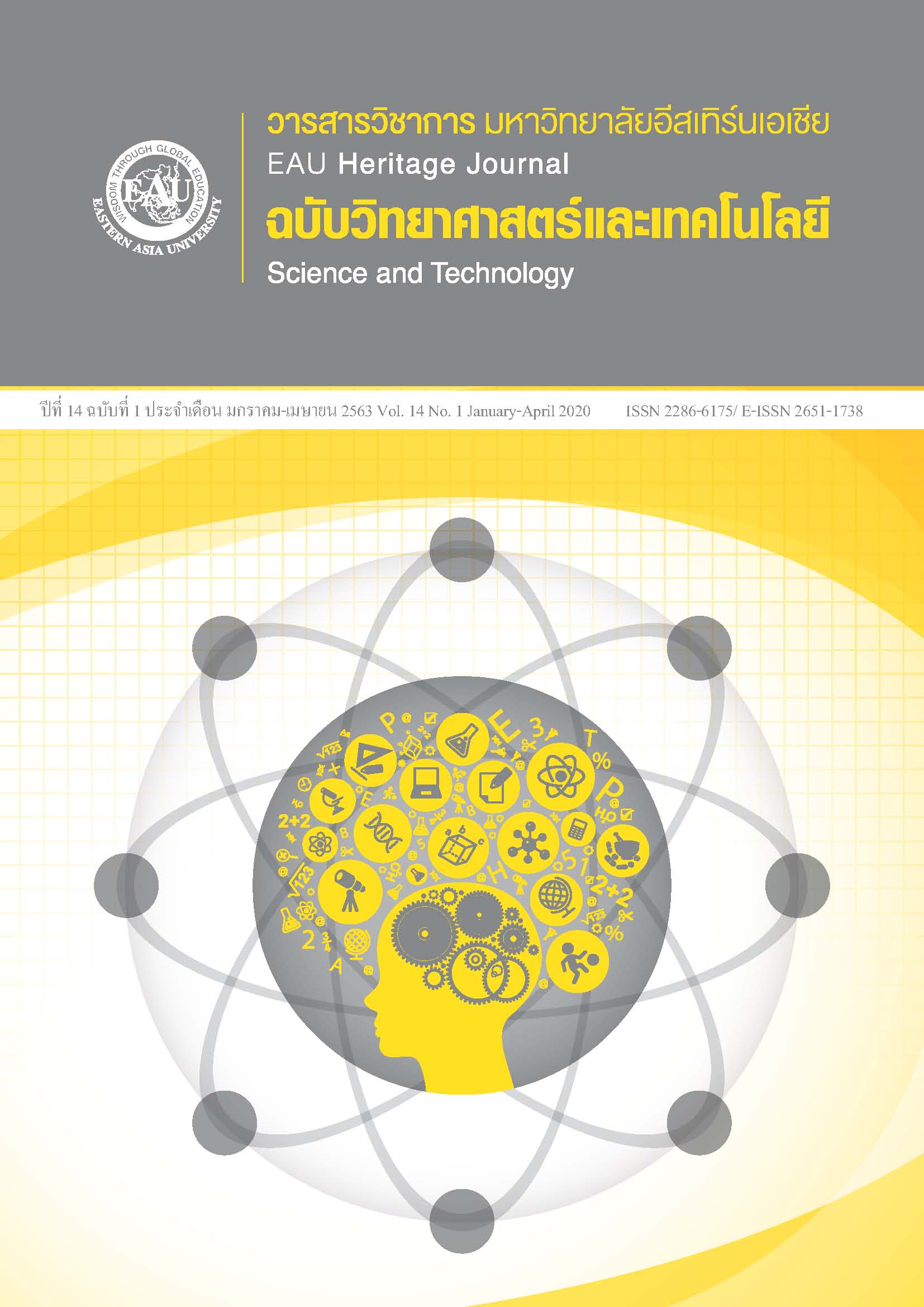การหากลุ่มสารสำคัญที่มีฤทธิ์ต้านจุลชีพของ Harrisonia perforata (Blanco) Merr. โดยวิธี Bioassay Guided Fractionation
คำสำคัญ:
ต้นคนทา, ฤทธิ์ต้านเชื้อจุลชีพ, ทีแอลซี ไบโอออโตกราฟีบทคัดย่อ
งานวิจัยนี้มีวัตถุประสงค์เพื่อศึกษาฤทธิ์ต้านเชื้อจุลชีพของสารสกัดเมทานอลจากใบคนทา และเพื่อศึกษากลุ่มของสารเคมีที่มีฤทธิ์ในการต้านเชื้อจุลชีพ โดยทดสอบกับเชื้อจุลชีพ 4 ชนิด คือ Staphylococcus aureus (S. aureus), Bacillus subtilis (B. subtilis), Escherichia coli (E.coli) และ Candida albicans (C.albicans) ด้วยวิธี disc diffusion ผลการทดลองพบว่า สารสกัดเมทานอลจากใบคนทามีฤทธิ์ต้านเชื้อ S. aureus และเชื้อ B. subtilis ซึ่งมีขนาดเส้นผ่าศูนย์กลางโซนใสเท่ากับ 7.01 และ 6.89 มิลลิเมตร ตามลำดับ และนำสารสกัดเมทานอลจากใบคนทาไปศึกษาต่อด้วยวิธี TLC-bioautography เพื่อศึกษากลุ่มสารออกฤทธิ์ต้านเชื้อจุลชีพโดยวิธีคอลัมน์โครมาโตกราฟี สามารถแบ่งสารสกัดหยาบได้ 2 ส่วน แบ่งเป็นสารสกัดแยกส่วนที่ 1 และสารสกัดแยกส่วนที่ 2 เมื่อทดสอบด้วยวิธี disc diffusion สารสกัดแยกส่วนที่ 1 มีฤทธิ์ต้านเชื้อ S. aureus และ B. subtilis โดยมีขนาดเส้นผ่าศูนย์กลางของโซนใส เท่ากับ 11.45 และ 8.96 มิลลิเมตร ตามลำดับ ส่วนสารสกัดแยกส่วนที่ 2 ให้ฤทธิ์ต้านเชื้อ B. subtilis โดยมีขนาดเส้นผ่าศูนย์กลางของโซนใส เท่ากับ 10.77 มิลลิเมตร และในการทดสอบหากลุ่มของสารสำคัญพบว่ามีสารสำคัญเป็นสารกลุ่มฟลาโวนอยด์ กลุ่มอัลคาลอยด์ กลุ่มไตรเทอร์ปินอยด์ และกลุ่มสเตียรอยด์
เอกสารอ้างอิง
Reference
Choodej, S., Sommit, D., & Pudhom, K. (2013). Rearranged limonoids and chromones from Harrisonia perforata and their anti-inflammatory activity. Bioorganic & Medicinal Chemistry Letter, 23(13), 3895-3900.
Limsong, J., Benjavongkulchai, E., & Kuvatanasuchati, J. (2004). Inhibitory effect of some herbal extracts on adherence of Streptococcus mutans. Journal of Ethnopharmacology. 92(2-3), 281-289.
Luvira, V. (2006). Overveiw of antibiotic resistance. Songklanagarind Medical Journal, 24(5), 453-459. (in Thai)
Phalanisong, P. (2008). Effect of some Thai medicinal plant extract on growth of Escherichia coli, Pseudomonas aeruginosa, Staphylococcus aureus and Staphylococcus epidermidis. Retrieved from https://archive.lib.cmu.ac.th. (in Thai)
Public health statistics, Ministry of public health. (2015). Ministry of Public Health 2015. Retrieved from https://bps.ops.moph.go.th. (in Thai)
Siriwong, N., Chukeatirote, E (2009). Antibiotic resistance in Staphylococcus aureus and controlling. Songklanakarind Medical Journal, 27(4), 347-358. (in Thai)
Sireeratawong, S., Lertprasertsuke, N., Srisawat, U., Thuppia, A., Ngamjariyawat, A., Suwanlikhid, N., & Jaijoy, K. (2009). Acute and subchronic toxicity study of the water extract from Harrisonia perforata merr. in rats. Songklanakarin Journal of Science and Technology, 31(1), 63-71. (in Thai)
Sirichitra, V. (1993). The testing of crude extract Harrisonia perforata against Streptococcus mutans and Actinobacillus actinomycetemcomitans. Journal of the Dental Association of Thailand, 43(6), 336-340. (in Thai)
Smittinand, T. (2014). Thai plant names (botanical names-vernacular names). Retrieved from https://www.qsbg.org/database/botanic_book%20full%20option/search_detail.asp?Botanic_ID=1000. (in Thai)
Somsil, P., & Ruangrungsi, N., Limpanasitikul, W., & Itthipanichpong, C. (2012). In vivo and in vitro anti-inflammatory activity of Harrisonia perforata root extract. Pharmacognosy Journal, 4(32), 38-44.
Tuntiwachwuttikul, P., Phansa, P., Pootaeng-On, Y., & Taylor, WC. (2006). Chromones from the branches of Harrisonia perforata. Chemical and pharmaceutical bulletin. 54(1), 44–47. DOI: 10.1248/cpb.54.44.
Yan,X.H.,Di, Y.T., Fang, X., Yang, S.Y., He, H.P., Li, S.L., Lu, Y., & Hao, X. J., (2011). Chemical constituents from fruits of Harrisonia perforata. Phytochemistry, 72(6), 508-513.







